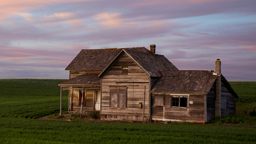
Which stain is best? Is an oil-based stain better than a water-based stain?
We’re sure you’ve seen at least five different answers to the same question. That doesn’t clear things up at all. So, let’s first start with a moment of truth: there are more stain types than just water- and oil-based. Each has its advantages. We’ll talk about that in a minute.
Here’s a quick checklist when deciding which stain to use.
1.) Is the stain made for logs?
Logs move – a lot – and take a beating from the sun much more than conventional lumber. The budget stains and deck stains you’ll find at the local hardware and paint store are much too rigid and will quickly crack, peel, and fade on logs. Manufacturers who make stain specifically for logs formulate more flexibility into their products to accommodate that movement, which means the stain will last longer.
2.) Are the stain, caulking and chinking compatible with one another?
It’s important to keep bugs and weather where they belong – outside. But if your stain, chinking, and caulking aren’t compatible with one another, that bug and weather barrier is compromised. When you consider that an average size log home has over one mile of caulking joints, making sure the stain you use will work with the sealants is critical. It’s easy to find out if they’re compatible: use a system from a manufacturer who specifically formulates their stains and sealants to work together, and if it’s not a system from the same manufacturer, be sure to contact both the maker of the stain and the maker of the sealants. Chances are, they’ve tested their product with others and know the answer to that question.
3.) What look do I want?
That picture in your minds’ eye is probably pretty developed. So, go get it! Answer these questions before you choose a stain type and it’ll help you narrow down the type you choose.
- What color do I want?
- What sheen do I want? Flat? Glossy? Somewhere in between?
- Am I going to do maintenance, or am I going to hire someone?
4. What stain type should I choose?
Not all stains are created equal, and how deep a stain penetrates doesn’t necessarily equate into better performance. See the charts below for the advantages of different stain types. Keep in mind: no matter what stain you choose, proper wood preparation is the most critical factor when it comes to longevity. So, don’t just consider the product, but also consider what kind of prep is necessary before you stain.
See also, How to Choose Stain for Your Log or Wood Home
See also, How to Choose Stain for Your Log or Wood Home
That said, on exposed logs and wood, it’s best to stick with either a surface stain or a shallow penetrating stain. Both will result in the best long-term durability and beauty you desire.
Surface Stains:
General Information:
- All are water-based
- Rely on excellent adhesion to wood fibers for good performance
- Leave behind a thin coating on the wood's surface
- Great for using on vertical walls, handrails, tongue & groove ceilings
- Not great for deck or roofs
Sheen:
- Eggshell, Satin, or Gloss (depends on brand and system)
Pros:
- High-performance brands have excellent UV protection
- High-performance brands have good to excellent elasticity, are able to handle log movement
- Many are easy to maintain with clear maintenance coat
- Breathable - will not trap moisture and allow moisture to escapeOf the three types, generally the most durable
- Generally compatible with sealants
- Will peel if proper wood prep is skipped
- Lack of routine maintenance will lead to cracking and peeling
- Cheaper/lower-quality formulas are rigid - will crack and peel quickly
Shallow Penetrating Stains:
General Information:
- Cheaper/lower-quality formulas are rigid - will crack and peel quickly
- Mostly hybrid (water-in-oil emulsions) and oil-based with drying oils
- Penetrate up to 5 wood cells deepLeaves behind a thin firm on the wood's surface
- Excellent for vertical walls, handrails, tongue & groove ceilings
- Some are good on decks
Sheen:
- Varies widely from flat to high gloss. Depends on type of raw materials used
Pros:
- High-performance brands have excellent UV protection
- High-performance brands have good to excellent elasticity, are able to handle log movement
- Easy to maintain with another coat of the same product, often in a lighter color
- Breathable - will not trap moisture and allow moisture to escape
Cons:
- Breathable - will not trap moisture and allow moisture to escap
- Oils are more rigid, which eventually leads to cracking and peelings
- Without proper prep and routine maintenance, will peel and crack early
Deep Penetrating Stains:
General Information:
- All are oil-based & contain non-drying oils (wax, silicone, etc.)
- Penetrate into wood 1/2" deep or more and stay for a long time
- Good for shingles
- High performance brands are good for deck surfaces
Sheen:
- Starts out gloss, dulls over time with exposure
Pros:
- Excellent moisture repellency
- Easy to apply and maintain
- Will peel if proper wood prep is ski
- Not compatible with sealants
- Poor UV resistance - color shifts and fades within a few months
- Appearance is short-lived, even with regular maintenance
5. How do I pick a color?
Color is a sensitive issue! Best way to get the color you want is to request samples and test several different stains. That said, stay away from clear stains. Why? A clear stain has very little UV protection in it. It’s like using an SPF 8 with no other sun protection. Your logs will get sunburned and discolored in very little time. Stick with high quality, UV absorbing stains loaded with pigments – which is where you get the majority of your UV protection – and follow these stain sampling procedures to make sure you get it right before you start.
Published on: January 9th, 2019
Like what your read? Need more information? We've asked industry experts, Sashco Sealants to help us answer your questions on all thing maintenance. Click here to see more.
Like what your read? Need more information? We've asked industry experts, Sashco Sealants to help us answer your questions on all thing maintenance. Click here to see more.










